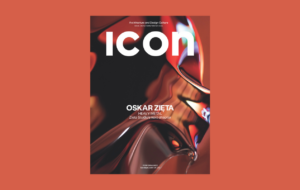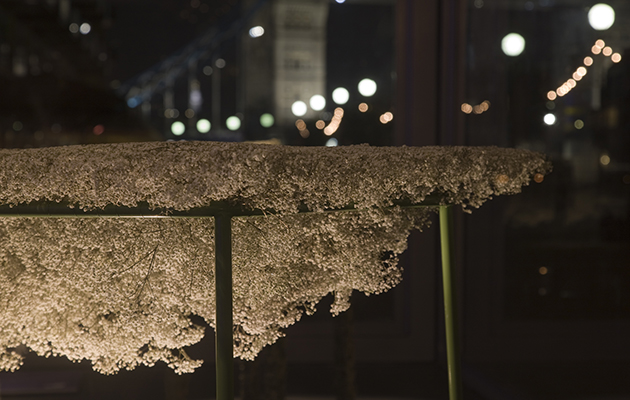
Asif Khan Harvest table. Photo: Luke Haye
The Design Museum’s influential Designers in Residence programme has much to celebrate in its 10th year, but the set-up is also facing new challenges, writes Riya Patel
There’s a chorus of haunting voices at the top of the Design Museum. They come from a tall column draped in white tassels, exuding a strange calm. It’s not out of place in the cathedral-like interior of the museum’s Kensington home.
But the sound installation is actually the work of Yinka Danmole, one of the museum’s 2017 Designers in Residence, made in collaboration with composer Michael Jon Mirza. Sounds of The People is an attempt to capture phrases from West African pidgin languages, giving them a fresh appreciation.
‘Support’
The theme for 2017’s programme was Support. Like other years, the one-word brief has spawned diverse responses from the chosen set. Sharing the space with Danmole’s eerie sound column is Chris Hildrey’s Addressing: the Problem, Soomi Park’s Embarrassed Robots, and Studio Ayaskan’s Transitions.
Hildrey’s project tackles a paradox of homelessness in the UK. To access services and benefits that might help a person escape homelessness, a xed address is required. His solution proposes to issue proxy addresses based on real but unused locations. Park’s Embarrassed Robots urges consideration of the role of emotions in artificial intelligence.
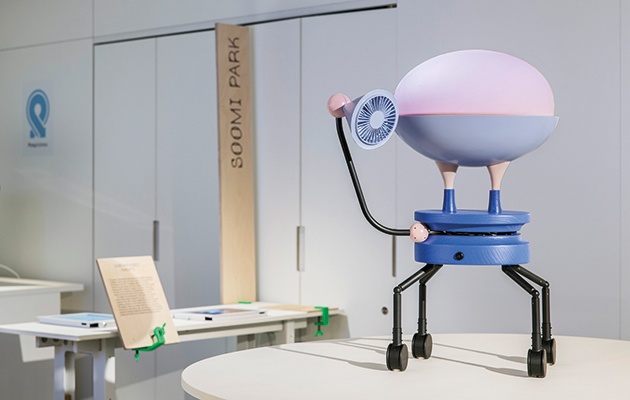
Soomi Park Embarrassed Robot
Her robot prototype blushes and fans itself when visitors come close. Studio Ayaskan (twins Bike and Begum Ayaskan) have explored the Earth’s natural cycles for their work Transitions. The series of three abstract timepieces is inspired by freeze-thaw action, changing water levels, and the refraction and dispersion of light.
Now in its tenth iteration, the Designers in Residence programme selects a group of early-career designers annually. Chosen from across the UK, they are set up with a bursary and an eight-month timeframe to explore a set theme. It was initiated in 2008, two years into Deyan Sudjic’s directorship.
Core part of the programming
He is part of the jury that selects the designers each year. The residency remains a core part of the museum’s programming, aimed at supporting young talent in their development between education and practice. Not all projects lead to a tangible, or even tidy, outcome, but the residents do usually make an accurate reflection of design’s wider concerns. And where the museum’s agenda lies too.
This year’s projects were defined by social conscience and ambition. While the discipline continues to struggle over whether it should charge itself with solving the world’s problems, these residents showed they’re ready to jump in, tackling complex and loaded subjects in a sensitive way.

Asif Khan Harvest 2 table. Photo: Luke Haye
The wide scope of the projects reflects the encouragement of a cross-disciplinary approach, although the curator acknowledges that the resulting display might be too abstract for many to fathom. ‘Some of the ideas are quite far-fetched, and people might question if they are design at all. But I guess it’s a presentation of the potential of what design could be,’ says Cubbage.
While the designers might already have experience in one eld they are expected to explore and engage with others. ‘What’s important now, more than ever, is a sense of engagement,’ she says. ‘We look for how open-minded the designers are, how keen they are to collaborate, and if they really have a broad outlook.’
What many designers find on the residency is the time to consider where they want their practice to go. Asif Khan was an early resident in 2010. In a conversation with Hildrey in the Designers in Residence catalogue, he says: ‘That was the purpose for me: to establish a mode of practice that suited my personality and what I wanted to spend my time doing.’
Exceptional Success
In the same cohort as Khan was Bethan Laura Wood. Her Moon Rock cabinets were the rst glimpse of an approach to colour and pattern that would play out in projects for Nilufar Gallery and Hermés. Of the 45 design residents so far, Khan and Wood are among a handful that have enjoyed exceptional success.
Other alumni are less recognisable. It seems the strong- minded fare well with the loose brief and relaxed guidance, whereas others struggle to capitalise on the opportunity at a volatile career stage. As the programme evolves it seems less suited to launching stellar careers, and more towards growing designers’ professional connections. In 2017, the residency is still a chance for a young designer to find direction.
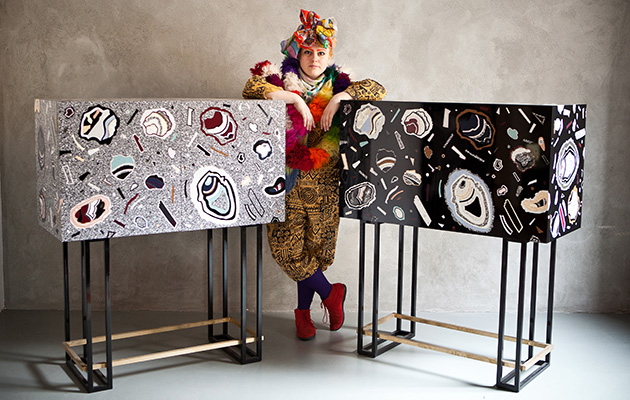
Bethan Laura Wood with her hot rock cabinets
The new space is aimed at facilitating live exchange between the designers and the public. The designers are asked to spend at least one day a week in the studio, where the public can drop in to ask about their projects. ‘The studio is really the space where we can show visitors where an idea comes from, what the designers are inspired by, and track their journeys,’ says Margaret Cubbage, programme director for seven of the ten cycles.
Positive public feedback
The theory, like more straightforward residencies, is also that the designers can make the most of proximity to the museum’s collections. In practice, it has worked to varying effect. Hildrey says public feedback on his project has been useful, owing to the social relevance of it.
Many challenges of the new set-up will be ironed out over time, but the live nature of the programme still poses questions. This year’s residents have disproved the idea of the designer as sole practitioner making physical things in a limited space.
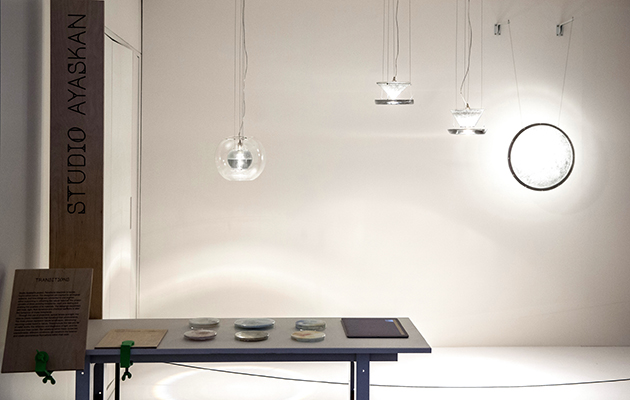
Transitions, by Studio Ayaskan
If the practice of design is becoming less hands-on, and more socially engaged, will there always be something stimulating for visitors to see? Even when hands-on work is involved, it’s often limited as to what can be done in public.
Breaking out of the box
As design breaks out of its disciplinary boundaries, containing the residents within their studio and a gallery set-up seems an ill t. Like their ambitious work, the designers could interject more into the social life of the museum, challenge the institutional context, and create surprising encounters. In its new location, the museum has made itself a temple of ‘good’ design, with a shrine at the top for showcasing the future.
Its residents show the reality of design is far more complicated and messy than that.
















